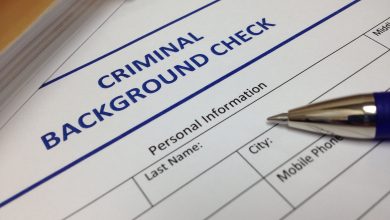Criminal Justice
20 Jobs You Can Get With A Job In Criminal Justice
What type of job can you get with a criminal justice degree? Getting a degree in criminal justice will enable you to get hired for many different jobs within the criminal justice field. There are lots of career choices that you can choose from other than police officer. It is possible to find a job that match’s your interests, abilities, abilities, and salary expectations with in criminal justice. This post provides descriptions of 20 jobs that you can pursue with a degree in criminal justice.
1 – Probation Officers
According to the US Bureau of Labor Statistics the 2019 median annual salary for probation officers was $47,200. Also, there is an estimated 18% job growth anticipated through 2020. Probation officers monitor parolees discharged from prison. They make sure they abide by the conditions of their probation with adapting to life after being discharged from prison. A probation officer is generally assigned a case load of parolees, who they periodically visit at their homes and workplace. Monitoring and rehabilitating parolees, provides probation officers the chance to create a positive difference in the lives of others. Individuals interested in the criminal justice system may find a career as a probation officer to be rewarding.
2 – Forensic Science
The US Bureau of Labor Statistics estimates that the yearly salary of forensic science technicians is $55,660. Although the average salary is greater in states like California, Virginia, and Illinois because because of higher needs for these experts. Salaries in these states is between $61,040 and $74,050. Aspiring forensic science professionals may get a head start as early as high school by focusing on mathematics and science. Forensic science technicians work in labs, government agencies, hospitals, and courtrooms. They also work in places where it is capable to reconstruct events according to clues like hair samples, broken substance, and fingerprints is required. This really is an exciting career for analytical heads with a fascination of mathematics.
3 – Police Officers
Police officers earn a mean yearly salary of $55,010, which was reported by the US Bureau of Labor Statistics. Requirement for police officers is anticipated to rise by 7%. Police officers are on the front line of the US criminal justice system. Their main function is to apprehend criminals and to reduce crime by having a community presence. Successful police forces invest in a great deal of training for their officers past just the degree and certificate. Additional training consists of cultural diversity, legal ethics, and law enforcement engineering. This can be a demanding and fast paced career with both professional and personal development opportunities.
4 – Correctional officials
Correctional officials, operate mostly inside jails and prisons to oversee and help those convicted of crimes. The average salary is $39,020 annually based on the Bureau of Labor Statistics. Incarceration systems are maintained by the local, state, and national levels. The job for correctional officers recently has changed from “protecting” inmates to rehabilitating inmates by improving their therapy programs while incarcerated.
5 – Private Detective
While they may help public detectives and local police forces, private detectives and investigators also take on cases in the personal realm which don’t involve a criminal component. The average salary is $48,610 based on the Bureau of Labor Statistics. Detectives are hired to find information associated with divorce cases, perform background checks, and investigate worker’s compensation claims. Knowledge of forensics as well as law is necessary to be able to collect evidence and do surveillance. This is why a degree in criminal justice in addition to some experience is necessary to become a private detective.
6 – Game Warden
For people who like the outdoors and criminal justice, a fish and game warden is the ideal career. The typical yearly salary of a fish and game warden is $55,670. Game and fish wardens operate in forest preserves, national parks, public areas, and other shielded regions that are conservation. They ensure that habitat and wildlife are protected and people are kept protected. Demand for game and fish wardens is best in states which have many active parks and natural areas, such as Texas and Florida.
7 – Security Guards
Security guards are always in demand. They are needed to protect individuals or property, which explains the reason why the Bureau of Labor Statistics is projecting 18% job growth in the next eight years. Security guards patrol the areas where there is suspicious or unusual activity and ensure all security guidelines are enforced. Security guards operate with law enforcement and the armed forces to discourage crime and ensure the safety of communities where they operate. Many private companies in need of security guards provide training and adaptive scheduling as part of the rewarding career.
8 – State Troopers
State troopers operate on county highways. They enforce driving laws such as speeding and seat belt usage. They are also responsible for enforcing less known legislation, like regulating the use, size, and gear of commercial vehicles for example semi-trucks. State troopers also assist federal and local law enforcement in searching for and apprehending wanted criminals, discovering illegal activity, and preventing terrorism. These professionals make a median salary of $55,010 reported from the Bureau of Labor Statistics. But state troopers that are highly trained may require a greater salary, particularly in higher risk locations.
9 – Crime Scene Investigators
As methods and technology placed science at the reach of police departments than in the past the area of science is growing. The requirement in this field is predicted to rise by 19 percent through 2020 in accordance with the Bureau of Labor Statistics, which makes this a fantastic area to pursue a diploma. Crime scene investigators operate on the area proof and in the laboratory assessing function that could support or contradict eyewitnesses, that evidence to reconstruct events — or fill in if no eyewitnesses are readily available. This can spot suspects in addition to establish the innocence of individuals wrongly accused of a crime, 9 which makes the job of crime scene investigators crucial to the due process of law.
10 – Computer Forensics
Computer forensic investigators or experts combine computer science and criminal justice. Computer forensic investigators collect activities and data on media instead of on crime scenes. As technology advances, crime is being solved with computers and digital devices. Criminals may attempt to ruin evidence by hiding it or physically destroying it. This is where computer forensics investigators come into play. They extract Information that help piece data together that criminals hoped were missing.
11 – Fraud Investigator
Fraud investigators make an average salary of $58,460 annually based on the Bureau of Labor Statistics, as a result of their own in-demand technical skills and expertise. Fraud investigators are required to decide whether a claim is accurate after another party or an insurance provider has paid for a claim. The Bureau of Labor Statistics forecasts that medical insurance fraud researchers will likely be in large demand in coming years because of the current national healthcare laws, making fraud evaluation a wonderful career option for future expansion.
12 – FBI Agent
FBI agents have a large number of duties. Many FBI agents concentrate in one field of law enforcement after graduating from training. The training is extremely strict. It includes almost 1,000 hours of instruction by professors, case exercises, firearms instruction, and surgeries. Following training, FBI agents can operate against terrorism, cyber crime, civil rights violations, public corruption, organized crime, violent crime, or even large thefts. To be able to become an FBI agent, applicants should possess a four year degree by an institution that is accredited.
13 – CIA Agent
Agents of the Central Intelligence Agency assist the government in exploring violations of the legislation all around the world. Like national representatives and police officers, CIA agents place their own lives in danger to protect their department and community. Most of the time they have to do this in secret. This element of danger contributes to the high salary of CIA agents. Agents located in Washington DC make between $74,872 and $155,500. CIA agents may be based out of satellite offices in the united states or overseas. CIA agents collaborate with other law enforcement agencies on a regular basis by bringing a distinctive mixture of skills obtained in CIA training to the table. Those interested in pursuing a job with the CIA must have a bachelor’s degree in an area related to law enforcement, forensics, language, or criminal justice, and have at least 5 years of work experience in the field.
14 – Postal Service Inspectors
As members of the United States Postal Service, inspectors resolve and investigate crimes linked to this US mail. Any moment a crime is committed that involves the mail, postal inspectors are most likely to be involved. Postal inspectors use question witnesses and study leads to address these crimes. To be able to be a postal inspector, applicants should have a four year degree in an accredited university or college and a clean criminal record. Applicants that are chosen receive 12 months of intense training in the US Postal Inspection Service Strategic Learning Services facility in Maryland.
15 – Immigration Enforcement Representatives
Immigration enforcement representatives are responsible for investigating, arresting, and deporting people who don’t have permission to be in the United States. To do so they keep up with current policies, make recommendations or demonstrations to courts hearing immigration cases, and take part in specific assignments, which might be covert. The US Immigration and Customs Enforcement branch is a part of the Department of Homeland Security. They offer employees a range of competitive advantages including lifetime and long-term care insurance, generous vacation time, flexible work schedules, and lodging reimbursement. Wages are based on expertise..
16 – Blood Splatter Scientists
As a blood splatter scientist, you can have a job analyzing blood at crime scenes. This requires physics, math and chemistry as your education basis. The mean salary of $53,090 is based on the Bureau of Labor Statistics. Blood spatter analysts see the scene of a crime, help find the blood and maintain the blood samples, and also do investigations. This analysis might consist of experiments to attempt and replicate a blood spatter pattern. Even tiny quantities of blood demand a educated blood spatter analyst’s evaluation. This is because blood patterns change based on movement, gravity, air pressure, quantity, the surface it lands , and lots of different factors. This profession isn’t for the faint of heart.
17 – Detectives
Detectives support police officers with apprehending suspects and resolving murders. The Bureau of Labor Statistics reports that the average salary of detectives in $55,010 annually, but since the job of a homicide detective is more stressful the salary for this job are often greater. Homicide detectives have to work to establish exactly how and why a murder was committed, what the rationale was, and what perpetrated the crime. They collect evidence, manage the work of crime scene technicians, identify and interview witnesses, and sometimes follow an unsolved crime for years; those investigations are known as cold cases. The type of work makes the livelihood of a homicide detective stressful, but homicide detectives provide a true difference in the communities where they serve.
18 – Drug Enforcement Administration agents
Drug Enforcement Administration agents, known as DEA agents, work to enforce the drug laws. Salaries for DEA agents are based on experience and education, but a salary of $49,746 is standard. Salaries can be as high as $92,592 or more. DEA agents dismantle drug traffickers and their organizations through covert and overt operations. They also study, monitor, and arrest traffickers. The DEA urges that applicants possess a bachelor’s degree with an interest on criminal justice, police science, or foreign languages. Applicants receive 18 weeks of basic agent training in the DEA Training Academy, and they get coaching opportunities that are ongoing. DEA agents should also be in excellent physical condition.
19 – Secret Service agents
Secret Service agents are the security detail that protects the President and other officials. The Secret Service is also tasked with protecting the ethics of the United States monetary systems by thwarting cyber attacks on banking procedures, identifying and eliminating counterfeit money from circulation, and investigating, arresting, and prosecuting criminals who violate the laws meant to safeguard our nation’s fiscal security. The Secret Service is involved with crimes like telecommunications and computer fraud and document forgery. Because of the nature of this job, the Secret Service agents are expected to be ready to travel often, possess a bachelor’s degree , and be in good shape. In return, agents receive comprehensive government advantages with a starting salary around $49,746, although this could be more depending on a person’s qualifications.
20 – US Marshals
US Marshals transport, handle, and protect prisoners and national witnesses; arrest wanted criminals; and administer the Department of Justice Asset Forfeiture Program, that seizes and sells resources purchased with illegally obtained money to compensate victims and finance law enforcement applications. As members of the country’s earliest law enforcement agency, US Marshals also offer security to judges, lawyers, and jurors in high profile or possibly dangerous court cases. What they’re best known for, however, is apprehending fugitives from the law; in 2010, the US Marshals detained over 36,000 fugitives — that is nearly 100 per day. To become a US Marshal, people need to have a bachelor’s degree or a combination of experience and education to satisfy the government’s GL-07 level classification. Instruction in police work, criminal justice, foreign languages helps applicants.



